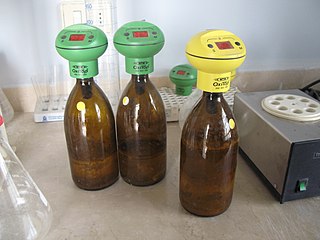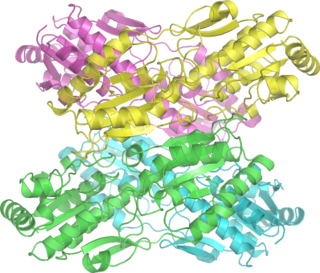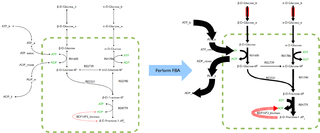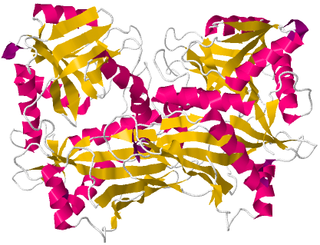Related Research Articles

Escherichia coli ( ESH-ə-RIK-ee-ə KOH-lye) is a gram-negative, facultative anaerobic, rod-shaped, coliform bacterium of the genus Escherichia that is commonly found in the lower intestine of warm-blooded organisms. Most E. coli strains are harmless, but some serotypes such as EPEC, and ETEC are pathogenic and can cause serious food poisoning in their hosts, and are occasionally responsible for food contamination incidents that prompt product recalls. Most strains are part of the normal microbiota of the gut and are harmless or even beneficial to humans (although these strains tend to be less studied than the pathogenic ones). For example, some strains of E. coli benefit their hosts by producing vitamin K2 or by preventing the colonization of the intestine by pathogenic bacteria. These mutually beneficial relationships between E. coli and humans are a type of mutualistic biological relationship — where both the humans and the E. coli are benefitting each other. E. coli is expelled into the environment within fecal matter. The bacterium grows massively in fresh fecal matter under aerobic conditions for three days, but its numbers decline slowly afterwards.

Bacterial growth is proliferation of bacterium into two daughter cells, in a process called binary fission. Providing no mutation event occurs, the resulting daughter cells are genetically identical to the original cell. Hence, bacterial growth occurs. Both daughter cells from the division do not necessarily survive. However, if the surviving number exceeds unity on average, the bacterial population undergoes exponential growth. The measurement of an exponential bacterial growth curve in batch culture was traditionally a part of the training of all microbiologists; the basic means requires bacterial enumeration by direct and individual, direct and bulk (biomass), indirect and individual, or indirect and bulk methods. Models reconcile theory with the measurements.

Biochemical oxygen demand is an analytical parameter representing the amount of dissolved oxygen (DO) consumed by aerobic bacteria growing on the organic material present in a water sample at a specific temperature over a specific time period. The BOD value is most commonly expressed in milligrams of oxygen consumed per liter of sample during 5 days of incubation at 20 °C and is often used as a surrogate of the degree of organic water pollution.

Phosphofructokinase-1 (PFK-1) is one of the most important regulatory enzymes of glycolysis. It is an allosteric enzyme made of 4 subunits and controlled by many activators and inhibitors. PFK-1 catalyzes the important "committed" step of glycolysis, the conversion of fructose 6-phosphate and ATP to fructose 1,6-bisphosphate and ADP. Glycolysis is the foundation for respiration, both anaerobic and aerobic. Because phosphofructokinase (PFK) catalyzes the ATP-dependent phosphorylation to convert fructose-6-phosphate into fructose 1,6-bisphosphate and ADP, it is one of the key regulatory steps of glycolysis. PFK is able to regulate glycolysis through allosteric inhibition, and in this way, the cell can increase or decrease the rate of glycolysis in response to the cell's energy requirements. For example, a high ratio of ATP to ADP will inhibit PFK and glycolysis. The key difference between the regulation of PFK in eukaryotes and prokaryotes is that in eukaryotes PFK is activated by fructose 2,6-bisphosphate. The purpose of fructose 2,6-bisphosphate is to supersede ATP inhibition, thus allowing eukaryotes to have greater sensitivity to regulation by hormones like glucagon and insulin.

Lactococcus lactis is a gram-positive bacterium used extensively in the production of buttermilk and cheese, but has also become famous as the first genetically modified organism to be used alive for the treatment of human disease. L. lactis cells are cocci that group in pairs and short chains, and, depending on growth conditions, appear ovoid with a typical length of 0.5 - 1.5 μm. L. lactis does not produce spores (nonsporulating) and are not motile (nonmotile). They have a homofermentative metabolism, meaning they produce lactic acid from sugars. They've also been reported to produce exclusive L-(+)-lactic acid. However, reported D-(−)-lactic acid can be produced when cultured at low pH. The capability to produce lactic acid is one of the reasons why L. lactis is one of the most important microorganisms in the dairy industry. Based on its history in food fermentation, L. lactis has generally recognized as safe (GRAS) status, with few case reports of it being an opportunistic pathogen.

Coliform bacteria are defined as either motile or non-motile Gram-negative non-spore forming bacilli that possess β-galactosidase to produce acids and gases under their optimal growth temperature of 35–37 °C. They can be aerobes or facultative aerobes, and are a commonly used indicator of low sanitary quality of foods, milk, and water. Coliforms can be found in the aquatic environment, in soil and on vegetation; they are universally present in large numbers in the feces of warm-blooded animals as they are known to inhabit the gastrointestinal system. While coliform bacteria are not normally causes of serious illness, they are easy to culture, and their presence is used to infer that other pathogenic organisms of fecal origin may be present in a sample, or that said sample is not safe to consume. Such pathogens include disease-causing bacteria, viruses, or protozoa and many multicellular parasites. Every drinking water source must be tested for the presence of these total coliform bacteria.

The Luria–Delbrück experiment (1943) demonstrated that in bacteria, genetic mutations arise in the absence of selective pressure rather than being a response to it. Thus, it concluded Darwin's theory of natural selection acting on random mutations applies to bacteria as well as to more complex organisms. Max Delbrück and Salvador Luria won the 1969 Nobel Prize in Physiology or Medicine in part for this work.
Bacterial translation is the process by which messenger RNA is translated into proteins in bacteria.

Filamentation is the anomalous growth of certain bacteria, such as Escherichia coli, in which cells continue to elongate but do not divide. The cells that result from elongation without division have multiple chromosomal copies.

Flux balance analysis (FBA) is a mathematical method for simulating metabolism in genome-scale reconstructions of metabolic networks. In comparison to traditional methods of modeling, FBA is less intensive in terms of the input data required for constructing the model. Simulations performed using FBA are computationally inexpensive and can calculate steady-state metabolic fluxes for large models in a few seconds on modern personal computers. The related method of metabolic pathway analysis seeks to find and list all possible pathways between metabolites.

A chemostat is a bioreactor to which fresh medium is continuously added, while culture liquid containing left over nutrients, metabolic end products and microorganisms is continuously removed at the same rate to keep the culture volume constant. By changing the rate with which medium is added to the bioreactor the specific growth rate of the microorganism can be easily controlled within limits.

In biochemistry, mixed acid fermentation is the metabolic process by which a six-carbon sugar is converted into a complex and variable mixture of acids. It is an anaerobic (non-oxygen-requiring) fermentation reaction that is common in bacteria. It is characteristic for members of the Enterobacteriaceae, a large family of Gram-negative bacteria that includes E. coli.

Branched-chain amino acid aminotransferase (BCAT), also known as branched-chain amino acid transaminase, is an aminotransferase enzyme (EC 2.6.1.42) which acts upon branched-chain amino acids (BCAAs). It is encoded by the BCAT2 gene in humans. The BCAT enzyme catalyzes the conversion of BCAAs and α-ketoglutarate into branched chain α-keto acids and glutamate.

Spot 42 (spf) RNA is a regulatory non-coding bacterial small RNA encoded by the spf gene. Spf is found in gammaproteobacteria and the majority of experimental work on Spot42 has been performed in Escherichia coli and recently in Aliivibrio salmonicida. In the cell Spot42 plays essential roles as a regulator in carbohydrate metabolism and uptake, and its expression is activated by glucose, and inhibited by the cAMP-CRP complex.

Biological exponential growth is the unrestricted growth of a population of organisms, occurring when resources in its habitat are unlimited. Most commonly apparent in species that reproduce quickly and asexually, like bacteria, exponential growth is intuitive from the fact that each organism can divide and produce two copies of itself. Each descendent bacterium can itself divide, again doubling the population size. The bacterium Escherichia coli, under optimal conditions, may divide as often as twice per hour. Left unrestricted, a colony would cover the Earth's surface in less than a day.
A turbidostat is a continuous microbiological culture device, similar to a chemostat or an auxostat, which has feedback between the turbidity of the culture vessel and the dilution rate. The theoretical relationship between growth in a chemostat and growth in a turbidostat is somewhat complex, in part because they are similar. A chemostat has a fixed volume and flow rate, and thus a fixed dilution rate. A turbidostat dynamically adjusts the flow rate to make the turbidity constant. At steady state, operation of both the chemostat and turbidostat are identical. It is only when classical chemostat assumptions are violated that a turbidostat is functionally different. One case may be while cells are growing at their maximum growth rate, in which case it is difficult to set a chemostat to the appropriate constant dilution rate.

The E. coli long-term evolution experiment (LTEE) is an ongoing study in experimental evolution begun by Richard Lenski at the University of California, Irvine, carried on by Lenski and colleagues at Michigan State University, and currently overseen by Jeffrey E. Barrick at the University of Texas at Austin. It has been tracking genetic changes in 12 initially identical populations of asexual Escherichia coli bacteria since 24 February 1988. Lenski performed the 10,000th transfer of the experiment on March 13, 2017. The populations reached over 73,000 generations in early 2020, shortly before being frozen because of the COVID-19 pandemic. In September 2020, the LTEE experiment was resumed using the frozen stocks.
Diauxic growth, diauxie or diphasic growth is any cell growth characterized by cellular growth in two phases. Diauxic growth, meaning double growth, is caused by the presence of two sugars on a culture growth media, one of which is easier for the target bacterium to metabolize. The preferred sugar is consumed first, which leads to rapid growth, followed by a lag phase. During the lag phase the cellular machinery used to metabolize the second sugar is activated and subsequently the second sugar is metabolized.
Impedance microbiology is a microbiological technique used to measure the microbial number density of a sample by monitoring the electrical parameters of the growth medium. The ability of microbial metabolism to change the electrical conductivity of the growth medium was discovered by Stewart and further studied by other scientists such as Oker-Blom, Parson and Allison in the first half of 20th century. However, it was only in the late 1970s that, thanks to computer-controlled systems used to monitor impedance, the technique showed its full potential, as discussed in the works of Fistenberg-Eden & Eden, Ur & Brown and Cady.
The Phage 21 S Family is a member of the Holin Superfamily II.
References
- ↑ Paalme, Toomas; Kahru, Anne; Elken, Raul; Vanatalu, Kalju; Tiisma, Kalle; Raivo, Vilu (1995). "The computer-controlled continuous culture of Escherichia coli with smooth change of dilution rate (A-stat)". Journal of Microbiological Methods. 24 (2): 145–153. doi:10.1016/0167-7012(95)00064-X.
- 1 2 Kasemets, Kaja; Drews, Monika; Nisamedtinov, Ildar; Adamberg, Kaarel; Paalme, Toomas (2003). "Modification of A-stat for the characterization of microorganisms". Journal of Microbiological Methods. 55 (1): 187–200. doi:10.1016/S0167-7012(03)00143-X. PMID 14500010.
- ↑ Lahtvee, Petri-Jaan; Adamberg, Kaarel; Arike, Liisa; Nahku, Ranno; Aller, Kadri; Vilu, Ranno (2011). "Multi-omics approach to study the growth efficiency and amino acid metabolism in Lactococcus lactis at various specific growth rates". Microbial Cell Factories. 10: 12. doi: 10.1186/1475-2859-10-12 . PMC 3049130 . PMID 21349178.
- 1 2 Valgepea, Kaspar; Adamberg, Kaarel; Nahku, Ranno; Lahtvee, Petri-Jaan; Arike, Liisa; Vilu, Ranno (2010). "Systems biology approach reveals that overflow metabolism of acetate in Escherichia coli is triggered by carbon catabolite repression of acetyl-CoA synthetase". BMC Systems Biology. 4: 166. doi: 10.1186/1752-0509-4-166 . PMC 3014970 . PMID 21122111.
- ↑ Lahtvee, Petri-Jaan; Valgepea, Kaspar; Nahku, Ranno; Abner, Kristo; Adamberg, Kaarel; Vilu, Raivo (2009). "Steady state growth space study of Lactococcus lactis in D-stat cultures". Antonie van Leeuwenhoek. 96 (4): 487–96. doi:10.1007/s10482-009-9363-2. PMID 19603284. S2CID 1002666.